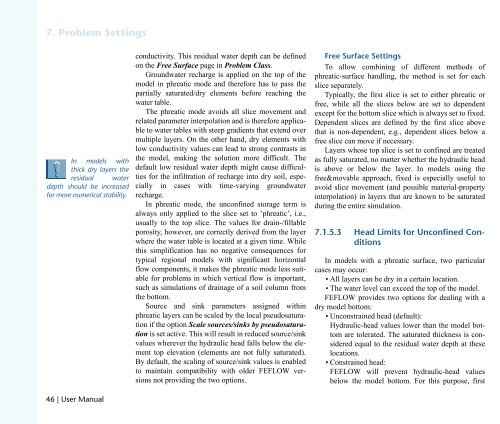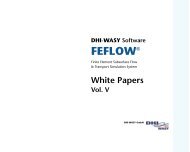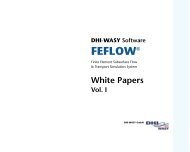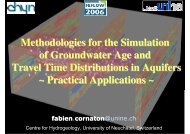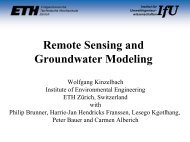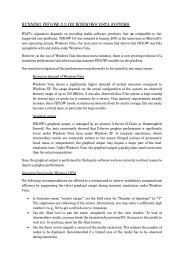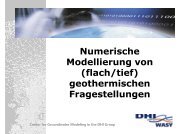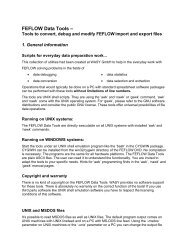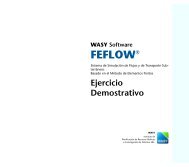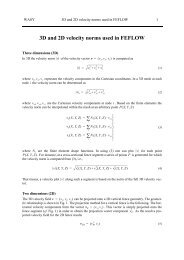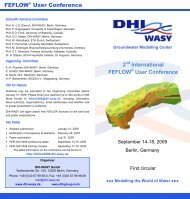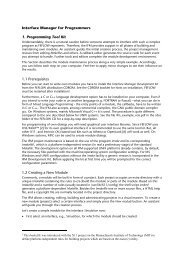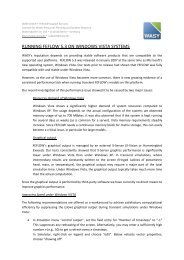DHIJWASv Software FEFLOW 6.1
DHIJWASv Software FEFLOW 6.1
DHIJWASv Software FEFLOW 6.1
Create successful ePaper yourself
Turn your PDF publications into a flip-book with our unique Google optimized e-Paper software.
TK=mêçÄäÉã=pÉííáåÖë<br />
få= ãçÇÉäë= ïáíÜ<br />
íÜáÅâ= Çêó= ä~óÉêë= íÜÉ<br />
êÉëáÇì~ä= ï~íÉê<br />
ÇÉéíÜ= ëÜçìäÇ= ÄÉ= áåÅêÉ~ëÉÇ<br />
Ñçê=ãçêÉ=åìãÉêáÅ~ä=ëí~ÄáäáíóK=<br />
QS=ö=rëÉê=j~åì~ä<br />
conductivity. This residual water depth can be defined<br />
on the Free Surface page in Problem Class.<br />
Groundwater recharge is applied on the top of the<br />
model in phreatic mode and therefore has to pass the<br />
partially saturated/dry elements before reaching the<br />
water table.<br />
The phreatic mode avoids all slice movement and<br />
related parameter interpolation and is therefore applicable<br />
to water tables with steep gradients that extend over<br />
multiple layers. On the other hand, dry elements with<br />
low conductivity values can lead to strong contrasts in<br />
the model, making the solution more difficult. The<br />
default low residual water depth might cause difficulties<br />
for the infiltration of recharge into dry soil, especially<br />
in cases with time-varying groundwater<br />
recharge.<br />
In phreatic mode, the unconfined storage term is<br />
always only applied to the slice set to ’phreatic’, i.e.,<br />
usually to the top slice. The values for drain-/fillable<br />
porosity, however, are correctly derived from the layer<br />
where the water table is located at a given time. While<br />
this simplification has no negative consequences for<br />
typical regional models with significant horizontal<br />
flow components, it makes the phreatic mode less suitable<br />
for problems in which vertical flow is important,<br />
such as simulations of drainage of a soil column from<br />
the bottom.<br />
Source and sink parameters assigned within<br />
phreatic layers can be scaled by the local pseudosaturation<br />
if the option Scale sources/sinks by pseudosaturation<br />
is set active. This will result in reduced source/sink<br />
values wherever the hydraulic head falls below the element<br />
top elevation (elements are not fully saturated).<br />
By default, the scaling of source/sink values is enabled<br />
to maintain compatibility with older <strong>FEFLOW</strong> versions<br />
not providing the two options.<br />
cêÉÉ=pìêÑ~ÅÉ=pÉííáåÖë<br />
To allow combining of different methods of<br />
phreatic-surface handling, the method is set for each<br />
slice separately.<br />
Typically, the first slice is set to either phreatic or<br />
free, while all the slices below are set to dependent<br />
except for the bottom slice which is always set to fixed.<br />
Dependent slices are defined by the first slice above<br />
that is non-dependent, e.g., dependent slices below a<br />
free slice can move if necessary.<br />
Layers whose top slice is set to confined are treated<br />
as fully saturated, no matter whether the hydraulic head<br />
is above or below the layer. In models using the<br />
free&movable approach, fixed is especially useful to<br />
avoid slice movement (and possible material-property<br />
interpolation) in layers that are known to be saturated<br />
during the entire simulation.<br />
TKNKRKP eÉ~Ç=iáãáíë=Ñçê=råÅçåÑáåÉÇ=`çåJ<br />
Çáíáçåë=<br />
In models with a phreatic surface, two particular<br />
cases may occur:<br />
• All layers can be dry in a certain location.<br />
• The water level can exceed the top of the model.<br />
<strong>FEFLOW</strong> provides two options for dealing with a<br />
dry model bottom:<br />
• Unconstrained head (default):<br />
Hydraulic-head values lower than the model bottom<br />
are tolerated. The saturated thickness is considered<br />
equal to the residual water depth at these<br />
locations.<br />
• Constrained head:<br />
<strong>FEFLOW</strong> will prevent hydraulic-head values<br />
below the model bottom. For this purpose, first


